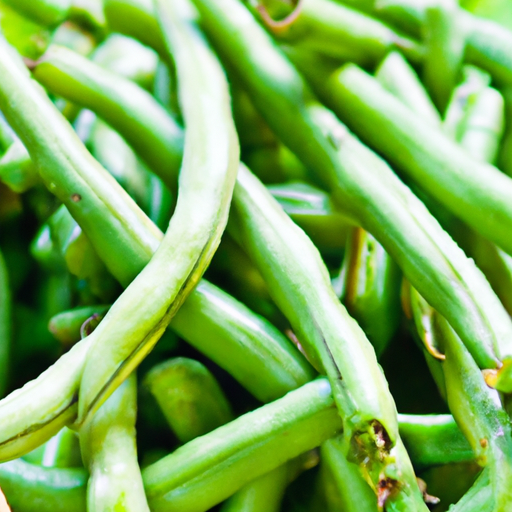The Marvelous Green Beans: A Delight for Your Palate
Green beans, also known as string beans or snap beans, are a versatile and nutritious vegetable that deserves a place of honor in your kitchen. These vibrant and slender pods offer a subtle and satisfying crunch, bursting with flavor that can elevate any meal. Whether you’re a seasoned cook or a beginner in the culinary realm, green beans are an excellent ingredient to experiment with due to their delicate taste and ability to complement a wide range of dishes.
Taste and Culinary Uses
Green beans have a refreshing and mildly sweet taste, a delightful balance between earthy and vegetal notes. They can be enjoyed raw, blanched, steamed, sautéed, stir-fried, roasted, or even pickled, making them a versatile addition to countless recipes. Their vibrant color can brighten up salads, stir-fries, and pastas, while their tender texture adds a satisfying element to any dish.
One popular method of preparing green beans is the classic French technique of blanching, which involves boiling the beans briefly and then plunging them into ice water. This helps to preserve their vibrant green color and crisp texture. Blanched green beans are often used in salads, as a side dish, or as a component in various appetizers.
In stir-fries, green beans add a nice crunch and absorb the flavors of the other ingredients in the dish. They pair well with garlic, ginger, soy sauce, and sesame oil, creating a harmonious blend of flavors.
Nutritional Value
Green beans not only provide a burst of flavor but also offer a wealth of nutrients that contribute to a well-rounded and healthy diet. These slim pods are packed with vitamins, minerals, and dietary fiber, making them a valuable addition to any meal plan.
One cup of cooked green beans contains approximately 44 calories, making them a low-calorie option for those looking to manage their weight. They are also an excellent source of vitamins A, C, and K, as well as folate and manganese.
The high fiber content in green beans promotes digestive health, aids in weight management, and helps reduce the risk of heart disease. Additionally, their antioxidants can help protect your body against cellular damage and support overall well-being.
From Ancient History to Modern Delights
Green beans have been a part of human cuisine for centuries, with their origins dating back to ancient Mesoamerica. They were cultivated by the ancient Aztecs and Mayans, and eventually made their way to Europe via Spanish explorers during the 16th century.
Interestingly, green beans were initially grown for their decorative qualities rather than their culinary value, with their stunning flowers adorning gardens across Europe. It wasn’t until the 18th century that people began to recognize and appreciate their delectable taste and wide-ranging culinary potential.
Today, green beans are celebrated in cuisines around the world. From the classic American Thanksgiving green bean casserole to the spicy Sichuan-style stir-fried green beans of China, these versatile pods have found their way into countless beloved recipes.
Green beans are a true delight to the palate. With their vibrant color, subtly sweet taste, and ability to enhance a wide range of dishes, they are a versatile and nutritious addition to any culinary repertoire. Whether you enjoy them blanched, sautéed, or roasted, green beans are sure to bring a burst of freshness to your plate. So, why not give these marvelous pods a try and experience a new world of flavors?
Sure! Here are some interesting facts about green beans:
Origin and History
- Green beans, also known as string beans or snap beans, are believed to have originated in Central and South America. They were cultivated by Mesoamerican civilizations long before the arrival of Europeans.
- Green beans were introduced to Europe by Christopher Columbus upon his return from the New World in the late 15th century.
- The popularity of green beans grew throughout Europe and eventually spread to other parts of the world.
Common Uses
- Green beans are widely used in various cuisines around the world, including stir-fries, salads, casseroles, and stews.
- They are often served as a side dish, steamed, boiled, or sautéed with other vegetables.
- Green beans are a common ingredient in the classic French dish “haricots verts,” where they are lightly cooked and served with butter or olive oil.
Nutritional Benefits
- Green beans are low in calories and a good source of fiber, vitamins (such as vitamin C, vitamin K, and folate), and minerals (such as potassium and manganese).
- They are rich in antioxidants that can help protect the body against oxidative stress and certain chronic diseases.
- The fiber content in green beans aids in digestion and helps maintain a healthy digestive system.
Unique Properties
- Green beans are classified as legumes and are related to other beans and peas.
- Unlike some other beans, green beans are harvested when the pods are still immature, which gives them their tender texture and mild flavor.
- Some green bean varieties have a stringy “string” along the seam of the pod, which needs to be removed before cooking. However, many modern varieties are stringless.
Remember to cook green beans until tender but still slightly crisp to preserve their vibrant color and nutrient content.




Use the share button below if you liked it.
It makes me smile, when I see it.